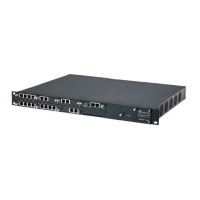Version 6.6 547 October 2014
Installation & Operation Manual 40. General SIP Configuration
40 General SIP Configuration
The general SIP configuration includes the following objects:
SIP Proxy Configuration
SIP Registrar Configuration
SIP Protocol Settings
Coders Table
IP Group Table
IP Profile Table
Account Group Table
Internal DNS Table
SIP SRV to IP Table
SRD Table
SIP Interfaces Table
NAT Translation Table
Least Cost Routing ( LCR )Table
40.1 The SIP Proxy
The SIP Proxy servers are used by Media Gateway board to perform the routing of
the SIP requests. Although you can configure internal SIP routing rules inside the
Media Gateway board, a centralized architecture in which routing is performed by a
SIP Proxy server (or a group of servers) is recommended for the typical Mediant 8000
installation.
40.1.1 SIP Proxy Set
The SIP Proxy Set is a group of SIP Proxy servers defined by IP address or fully
qualified domain name (FQDN). You can define up to six Proxy Sets, each with a
unique ID number and each containing up to five Proxy server addresses. For each
Proxy server address, you can define the transport type (i.e., UDP, TCP, or TLS). In
addition, Proxy load balancing and redundancy mechanisms can be applied per Proxy
Set (if a Proxy Set contains more than one Proxy address).
Proxy Sets can later be assigned to IP Groups of type SERVER only (see 'IP Groups
Table' on page 611 ). When the device sends an INVITE message to an IP Group, it is
sent to the IP address/domain name defined for the Proxy Set that is associated with
the specific IP Group. In other words, the Proxy Set represents the destination of the
call.
Typically, for IP-to-IP call routing, at least two Proxy Sets are defined for the call
destination – one for each leg (IP Group) of the call (i.e., both directions). For
example, one Proxy Set for the Internet Telephony Service provider (ITSP) interfacing
with one 'leg' of the device and another Proxy Set for the second SIP entity (e.g.,
ITSP) interfacing with the other 'leg' of the device.

